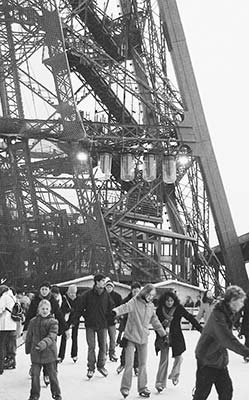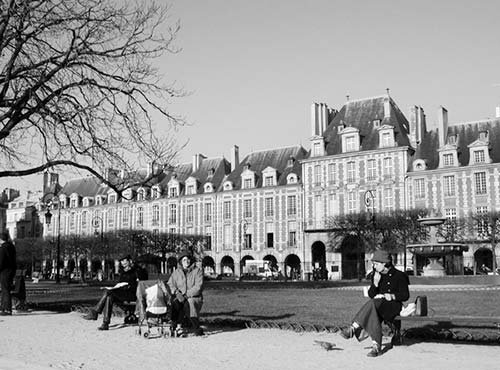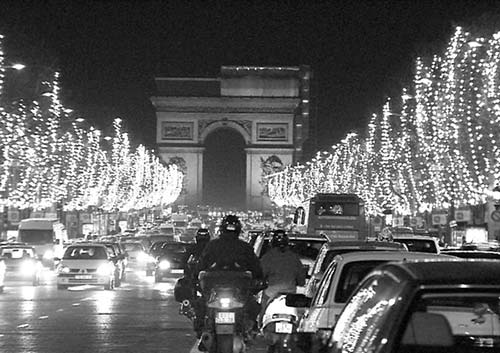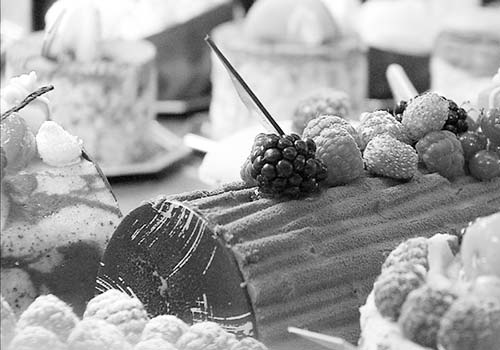
Christmas Eve and Christmas Day
The City of Light sparkles year-round, but Paris has a special appeal in winter. You’ll find inexpensive airfares, fewer crowds, and soft prices for hotel rooms and apartments (rent one for a week or more). Sure, the weather can be cold and rainy (average high in Dec is 44°F), but if you dress in layers, you’ll keep warm and easily deal with temperature changes as you go from cold streets to heated museums and cafés.
Museums, restaurants, and stores stay open as usual; the concert and arts season is in full bloom; and Paris belongs to the Parisians. So go local, save money, and skip the museum lines that confound peak-season travelers. There are worse ways to spend a wintry day than enjoying world-class art, architecture, and shopping, then lingering over a fine dinner at a cozy corner bistro in the evening. As Cole Porter put it: “I love Paris in the winter, when it drizzles.”
Slow down and savor your favorite museums and monuments—spending one-on-one time with Mona and Venus is worth the extra clothes you have to pack. Attend a cooking demonstration, take a short course in art or architecture, or dabble in a wine-tasting class (for details, see the sidebar on here). Duck into cafés for a break from sightseeing or shopping and to warm up. Get on a first-name basis with the waiter at your corner café—just because you can now.
Easter marks the start of the tourist season, when locals find they need to make reservations for their favorite restaurants and can no longer find seats on the Métro.
This chapter reviews off-season highlights in Paris, but remember—your reward for traveling in winter is the joy of feeling part of a city, like you almost belong here. That’s what you’ll find on a trip to Paris from November to March.
From late October well into November, leaves tumble from Paris’ trees, revealing magnificent building facades and turning parks into austere yet romantic places. Winter also brings early sunsets and long evenings, ideal for floodlit neighborhood walks, boat rides, and taxi tours that allow you to view the City of Light at a reasonable hour.

If you’re in Paris over the Thanksgiving holiday, you can watch with amusement as the entire expat community crams themselves into the tiny food shop aptly named Thanksgiving to purchase overpriced cranberries and boxes of stuffing (20 Rue St-Paul, Mo: St-Paul).
Beginning one minute after midnight on the third Thursday of November and running through mid-December, Paris welcomes the arrival of the Beaujolais Nouveau with an enthusiasm uncharacteristic for such a coolly indifferent place. The fresh, fruity wine is rushed from vineyards a bit north of Lyon directly to Paris, where wine bars and most cafés serve it happily, buzzing with news of the latest vintage. The first 24 hours are the most fun and raucous, and it’s easy to join the party if you don’t mind elbowing your way to the comptoir for un verre. Cafés and bistros continue the celebration for weeks, many offering special dishes with a glass of the Beaujolais Nouveau.
And speaking of wine, the annual Salon des Vins des Vignerons Indépendents (independent winemakers’ trade show) is held in Paris on the last weekend of November at the Porte de Versailles exhibition center (Mo: Porte de Versailles, line 12). Here, anyone can sample fine wines from more than 1,000 different stands (small entry fee, ask your hotelier for details or check www.france-independent-winegrowers.com).
One of Europe’s greatest treats is strolling down the glowing Champs-Elysées in winter. From late November through early January, holiday lights adorn city streets, buildings, and monuments, and the Champs-Elysées beams with a dazzling display of lights on the trees that line the long boulevard. The city springs for 1,000 fresh-cut fir trees to put up and decorate around town, 300 of which ring the Rond-Point roundabout at the lower end of the Champs-Elysées. You’ll also find cheerful lighting displays on many traffic-free streets, including Rues Cler, Montorgueil, and Daguerre.

Parisians live to window shop (remember that faire du lèche-vitrines means “window licking”). Do some licking of your own along Boulevard Haussmann and view the storefront lights and wild window displays at the grand department stores such as Printemps and Galeries Lafayette. Here you can have your picture taken with Père Noël—France’s slimmer version of Santa Claus, dressed in red trimmed with white fur. The seasonal displays in neighborhood boutiques around Sèvres-Babylone and in the Marais (among other areas) are more intimate and offer a good contrast to the shows of glitz around the department stores.
Several ice-skating rinks open up in festive locations, allowing you to glide and twirl in front of the Hôtel de Ville (Paris’ main City Hall, look also for a small sled run) and along a portion of the Champs-Elysées. The rinks are free to use (around €5 to rent skates, generally open late Nov-Jan from noon into the evening).
For the kids, there are Christmas carousels (Manèges de Noël) that whirl at various locations, including the biggies at Hôtel de Ville, the Eiffel Tower, and at the base of Sacré-Cœur in Montmartre. As soon as school lets out, parks come alive with pony rides, puppet shows, and other activities.
The dazzling château Vaux-le-Vicomte, an hour south of Paris, opens for Christmas with special holiday decorations (€20, weekends only Dec-early Jan 10:45-18:00; see here for details on the château).
With the arrival of St. Nicholas on December 6, the Christmas season kicks into gear. (Bear in mind, though, that Paris celebrates Christmas with only a fraction of the holiday cheer and commercialism that you’ll find in the States.) In mid-December, Christmas markets pop up, particularly on the Left Bank (St. Sulpice and St. Germain-des-Prés), along the Champs-Elysées, and clustered around the Abbesses Métro stop in Montmartre. At Notre-Dame, a big Christmas tree goes up, and they may have a living crêche in front. Parisians pick up tiny and expensive Christmas trees for their homes at flower shops—if you rent an apartment, you could do the same. Be sure to check the Pariscope magazine for popular and often free or inexpensive Christmas concerts.
The big event is the Christmas Eve dinner, called La Réveillon—“the awakening”—when Parisians stay awake late to celebrate the arrival of Jesus. Traditionally, they attend evening Mass (at Notre-Dame, among other churches), then meet with family and friends for a big feast. The meal begins with (what else?) escargots, smoked salmon or oysters, and then foie gras. The main dish, similar to American Thanksgiving, is turkey, served with chestnuts and potatoes (gratin dauphinois). This evening is normally celebrated at home and with family, though some Paris restaurants (and other businesses) stay open late to accommodate parties indulging in raw oysters, cheese, and the Yule Log (Bûche de Noël)—a log-shaped sponge cake iced with chocolate “bark.” After dinner the kiddies leave their slippers next to the fireplace for Père Noël to fill with treats.

On Christmas Day, Paris is very sleepy—make arrangements ahead of time if you’ve got a plane to catch, and don’t plan on visiting the Louvre (which is closed, along with most museums and businesses). Visitors looking for religious services in English will find no shortage of churches to attend—choose between the interdenominational American Church, American Cathedral, Unitarian Church, and St. George’s Anglican Church (listed in the appendix). Many of these churches—especially the American Church—also offer Christmas concerts.
All of Paris parties on New Year’s Eve, and a table at a restaurant is next to impossible to land (book early or dine at a café). The holidays aren’t over yet—Paris celebrates the arrival of the Three Kings on Epiphany (Jan 6) with as much fanfare as Christmas itself. Twinkling Christmas lights stay lit through most of the month.
The after-Christmas sales (soldes) are an even bigger post-holiday tradition, as locals jam boutiques and department stores looking for bargains. These sales, which last until early February, force stores to keep longer hours.
Parisians celebrate the Chinese New Year in a big way (usually falls near the end of January) with parades, decorations, and fanfare. Ask your hotelier or a TI for parade locations.
These are the quiet months, when Paris is most alone with itself. And though holiday decorations disappear, the City of Light is as beautiful and seductive as ever. Romantics enjoy Paris on Valentine’s Day, of course, and there is no shortage of romantic places to linger in Paris.
Someday, visit Paris in winter and—for a few days—become a Parisian.